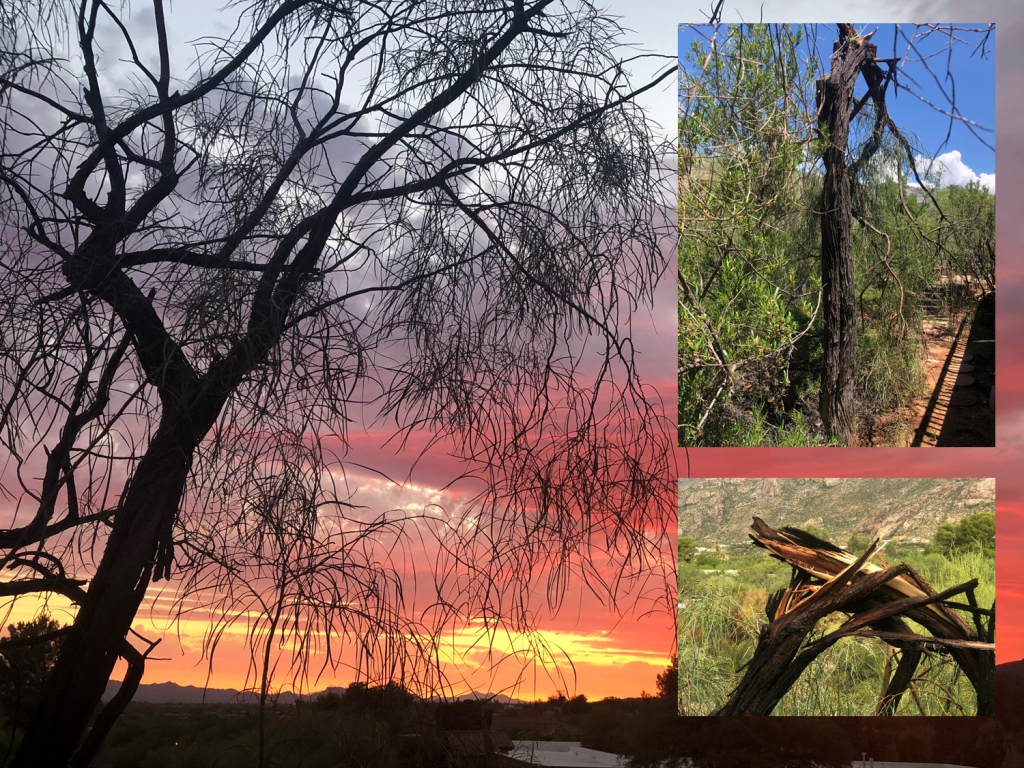It was the view that sold us. In 1986, Kris and I decided to upgrade from the modest home we bought before I enrolled in law school. We looked at several houses but ended our search and made an offer when we saw the view. The house was small for the neighborhood, but big enough for us. The floorplan was efficient and well-designed, but we were captivated by the view. The house has a large, partially covered deck on the north side. The Catalina Mountains loom over us in that direction. The view to the west, toward the end of the deck, stretched to the western mountains, unimpaired except for a single tree.
The tree was a Shoestring Acacia that towered over the deck. It didn’t block the view as much as it enhanced it. The Moon Valley Nurseries website describes the Shoestring Acacia as “an almost perfect medium-sized tree with a weeping habit and long and narrow green leaves that provide filtered shade and also help give it its ‘shoestring’ appearance.” It’s native to Australia.
Our tree had a double trunk, which gave it a heart-shaped profile. Its green tendrils didn’t cast much shade, but also didn’t block the view. It was part of the view. From the flaming sunsets of monsoon season to the grey clouds of winter, from the bottomless blue sky of Spring to the appearance of distant city lights at dusk, the tree was like an actress on an ever-changing stage.
Life is riddled with uncertainty. I think that’s why many of us find solace in the stability and permanence of mountains and trees. Mountains are solid and reassuring. So was our Shoestring Acacia, posing before the western sky, there to greet us every morning, still there to kiss the evening goodbye hours later.
Our daughter, Meg, was a little girl when we moved into the house with the Shoestring Acacia and regarded it as a member of the family. She named it “Siouxhima.”
Siouxhima stood just outside the deck perimeter. The tree had many visitors over the years. Mourning doves would softly coo in her branches. Bright red cardinals would happily chirp and sing there as well. Majestic hawks rested in Siouxhima. Even roadrunners were attracted to her lofty, wispy branches. One day, to my amazement, I saw a juvenile bobcat in her arms. The bobcat was paralyzed with fright while our dog, Penny, robustly barked at it. I pulled Penny away and the little bobcat gingerly clambered down.
The historic drought impacted many local plants as it tightened its grip on the Southwest. Siouxhima was not immune. One of her trunks died, but remained in place. It was like a symbol of life and death, two opposites collapsed into a common entity. The heart-shaped symmetry remained. Siouxhima stood proudly on one side, humbly on the other.
We eventually hired an arborist to remove the dead portion. Its fragility had made it potentially dangerous, especially during monsoon season. I’ve seen large, healthy branches ripped from trees and sucked into the sky. Siouxhima’s brittle dead portion would not put up much resistance.
Siouxhima looked like half a tree, but we watered and nurtured her and she eventually regained her regal symmetry. Siouxhima had suffered and changed, but endured. She was emblematic of the region in that way. From the devastating flood of October 1983 to the Aspen and Big Horn fires in the Catalinas, the community has survived. We have been burnt, broken, submerged and humbled. We have lost pieces of ourselves, bent under the weight of events, but continue on our way, damaged, scarred, and defiant. Just like Siouxhima.
On July 30, 2022, a violent squall passed over our neighborhood. The rain overwhelmed our gutters, creating a waterfall where the water poured off the covered part of the deck. I took a video of the impromptu waterfall. As I did so, I slowly panned left, capturing the ferocity of the storm. All I could see was shrubbery flailing violently in the wind, the rain whipping sideways and a turbulent, boiling grey mass where the mountains used to be. It was a classic monsoon storm, the kind I have loved, feared, and photographed all of my life.
As I panned farther left, I heard a loud, sickening, cracking sound. I continued slowly panning from right to left. I didn’t turn to look at what had caused the ugly sound. I didn’t have to; I knew what the sound was.
It was the sound of Siouxhima dying.
I panned farther to my left, toward the west, toward Siouxhima. She was broken in two, her upper part dangling helplessly over the lower part. My eyes brimmed with tears as I momentarily froze the camera on her carcass, then zoomed in for a closer look. No tree could survive a catastrophic break like that. Siouxhima was gone.
On Monday, I hired Jose Leal of Angel’s Landscaping to remove Siouxhima’s remains. She was cut up and hauled away in less than an hour. The tree was beyond survival and the dead remnants could tear loose and become projectiles in the monsoon wind.
We had a vibrant sunset that night, as if the sky had painted a visual elegy to our lost friend. I took a photograph. The western view was unimpaired, with nothing between me and the distant horizon, a stunning sight.
But so horribly empty.
© 2022 by Mike Tully
<<< YOU CAN READ / DOWNLOAD A PDF VERSION BY CLICKING HERE >>>


Be First to Comment